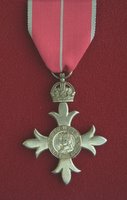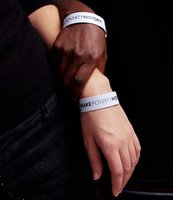
The Most Excellent Order of the British Empire is an order of chivalry established on 4 June 1917 by George V. The Order includes five classes in civil and military divisions, in decreasing order of seniority:
Knight or Dame Grand Cross (GBE)
Knight or Dame Commander (KBE or DBE)
Commander (CBE)
Officer (OBE)
Member (MBE)
Only the two highest ranks entail admission into knighthood. There is also a related British Empire Medal, whose recipients are not members of the Order, but which is affiliated with the Order nonetheless. This is no longer conferred in the United Kingdom, but is still used in some overseas territories and Commonwealth nations.
The Order's motto is For God and the Empire. It is the most junior of the British orders of chivalry and has more members than any other.
HistoryKing George V founded the Order to fill gaps in the British honours system: The Most Honourable Order of the Bath honoured only senior military officers and civil servants, The Most Distinguished Order of St Michael and St George honoured diplomats and the Royal Victorian Order honoured those who had personally served the Royal Family. In particular, King George V wished to honour the many thousands of
people who served in numerous non-combatant capacities during the First World War. Originally, the Order included only one division; soon after its foundation, in 1918, it was formally divided into Military and Civil Divisions. This Order of Knighthood has a more democratic character than the exclusive orders of the Bath or Saint Michael and Saint George, and in its early days was not held in high esteem. This changed over the years.
CompositionQueen Elizabeth II & Prince Philip in the robes of the Order of the British EmpireThe British Sovereign is the Sovereign of the Order and appoints all other members of the Order (by convention, on the advice of the Government). The next-most senior member is the Grand Master. The current Grand Master is HRH The Duke of Edinburgh.
The Order is limited to 100 Knights and Dames Grand Cross, 845 Knights and Dames Commander, and 8960 Commanders. There are no limits on the total number of members of the fourth and fifth classes, but no more than 858 Officers and 1464 Members may be appointed per year. Appointments are made on the advice of the governments of the United Kingdom and some Commonwealth realms. By convention, female judges of the High Court of England and Wales are created Dames Commander after appointment. Male judges, however, are created Knights Bachelor.
Although the Order of the British Empire has by far the highest number of members of the British Orders of Chivalry, there are fewer appointments to knighthoods than in other orders. Most Knights Commander are honorary members or British subjects living abroad, with only a handful being residents of the United Kingdom. The grade of Dame Commander, on the other hand, is the commonest grade of dame in the British honours system and is awarded in circumstances where men would be created Knights Bachelor.
Most members are citizens of the United Kingdom or other Commonwealth realms ruled by the Queen. Citizens of other countries, however, may be admitted as "honorary members". They do not count towards the numerical limits aforementioned, nor are holders of the GBE, KBE or DBE addressed as "Sir" or "Dame". (They may be made full members if they subsequently become British citizens.) See List of honorary British Knights.
At the foundation of the Order, the "Medal of the Order of the British Empire" was instituted. In 1922, it was renamed the "British Empire Medal". Recipients, who are not members of the Order itself, are grouped into the Civil and Military Divisions. Only junior government and military officials are awarded the medal; senior officials are directly appointed to the Order of the British Empire. The United Kingdom's Government has not recommended the awarding of the medal since 1992, though some Commonwealth realms continue the practice.
The Order has six officials: the Prelate, the Dean, the Secretary, the Registrar, the King of Arms and the Usher. The Bishop of London, a senior bishop in the Church of England, serves as the Order's Prelate. The Dean of St Paul's is ex officio the Dean of the Order. The Order's King of Arms is not a member of the College of Arms, like many other heraldic officers. The Usher of the Order is known as the Gentleman
Usher of the Purple Rod; he does not, unlike his Order of the Garter equivalent (the Gentleman Usher of the Black Rod), perform any duties related to the House of Lords.
ChapelThe chapel of the order is in the far eastern end of the crypt of St Paul's Cathedral, but it holds its great services upstairs in the main body of the cathedral. (The Cathedral also serves as the home of the chapel of The Most Distinguished Order of St Michael and St George.) Religious services for the whole Order are held quadrennially; new Knights and Dames Grand Cross are installed at these services. The chapel was dedicated in 1960.
Precedence and privilegesMembers of all classes of the Order are assigned positions in the order of precedence. Wives of male members of all classes also feature on the order of precedence, as do sons, daughters and daughters-in-law of Knights Grand Cross and Knights Commander; relatives of Ladies of the Order, however, are not assigned any special precedence. (As a general rule, individuals can derive precedence from their fathers or husbands, but not from their mothers or wives.) (See order of precedence in England and Wales for the exact positions.)
Knights Grand Cross and Knights Commander prefix "Sir", and Dames Grand Cross and Dames Commander prefix "Dame", to their forenames. Wives of Knights may prefix "Lady" to their surnames, but no equivalent privilege exists for husbands of Dames. Such forms are not used by peers and princes, except when the names of the former are written out in their fullest forms. Clergy of the Church of England do
not use the titles of "Sir" or "Dame" and do not receive the accolade (i.e. are not dubbed knight with a sword, as are other knights, but not dames), although they do append the post-nominal letters.
Knights and Dames Grand Cross use the post-nominal "GBE", Knights Commander "KBE", Dames Commander "DBE", Commanders "CBE", Officers "OBE" and Members "MBE". The post-nominal for the British Empire Medal is "BEM".
Knights and Dames Grand Cross and Knights and Dames Commander who are not subjects of the Queen (i.e. not citizens of the United Kingdom or another country ruled by the Queen) are not entitled to the prefix "Sir" or "Dame", but may still use the post-nominal abbreviations. For example, Bill Gates was made a Knight Commander of the British Empire but is not entitled "Sir William" or "Sir William Gates III", but may use "William Henry Gates III, KBE". Honorary knights do not receive the accolade. If they later become subjects of the Queen then they are entitled to begin using the prefix as well.
Knights and Dames Grand Cross are also entitled to receive heraldic supporters. They may, furthermore, encircle their arms with a depiction of the circlet (a circle bearing the motto) and the collar; the former is shown either outside or on top of the latter. Knights and Dames Commander and Commanders may display the circlet, but not the collar, surrounding their arms. The badge is depicted suspended from the collar or circlet
 I typed "www.heinz.com" into our browser's location bar, and was quickly rewarded with the Heinz web site, and clicked on the Consumer FAQs section, always my first stop when looking for an answer to this type of question. I scanned the entries and soon found a similar question:
I typed "www.heinz.com" into our browser's location bar, and was quickly rewarded with the Heinz web site, and clicked on the Consumer FAQs section, always my first stop when looking for an answer to this type of question. I scanned the entries and soon found a similar question:



































 Add my feed to your Rss
Add my feed to your Rss
